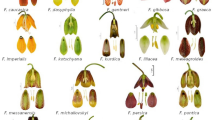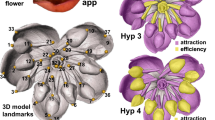Abstract
PLANTS have evolved traits that enable them to influence directly the behaviour and movement of their pollinators. Here I show that flowers in at least 74 diverse angiosperm families undergo dramatic, often localized, colour changes which direct the movements of a variety of pollinators to the benefit of both participants. Floral colour change was first noted almost 200 years ago1 and is known in a variety of species2–17, but the prevalence and significance of the phenomenon have gone largely unrecognized. I find that retention of older flowers increases a plant's attractiveness to pollinators from a distance, that pollinators discriminate between floral colour phases at close range, and that the discrimination involves learning. The phenomenon of floral colour change is taxonomically widespread, morphologically variable (Fig. 1), and physiologically diverse. It has evolved independently in the angiosperms many times and provides a striking example of functional convergence.
This is a preview of subscription content, access via your institution
Access options
Subscribe to this journal
Receive 51 print issues and online access
$199.00 per year
only $3.90 per issue
Buy this article
- Purchase on Springer Link
- Instant access to full article PDF
Prices may be subject to local taxes which are calculated during checkout
Similar content being viewed by others
References
Sprengel, C. K. Das Entdeckte Geheimniss der Natur im Bau und in der Befruchtung der Blumen (Vieweg, 1793).
Delpino, F. Atti Soc. ital. Sci. nat. 16, 151–349 (1873).
Müller, F. Nature 17, 78–79 (1877).
Müller, H. Nature 28, 81 (1883).
Kugler, H. Ergebn. Biol. 19, 143–323 (1943).
Vogel, S. Öst. bot. Z. 97, 44–100 (1950).
Dunn, D. B. Am. Midl. Nat. 555, 443–472 (1956).
Wainwright, C. M. Bull. Torrey Bot. Club 105, 24–38 (1978).
Schaal, B. A. & Leverich, W. J. S. West. Nat. 25, 280–282 (1980).
Gori, D. F. in Handbook of Experimental Pollination Biology (eds Jones, C. E. & Little, R. J.) (Van Nostrand Reinhold, New York, 1983).
Casper, B. B. & La Pine, T. R. Evolution 38, 128–141 (1984).
Lamont, B. Bot. J. Linn. Soc. 90, 145–155 (1985).
Mathur, G. & Mohan Ram, H. Y. Phytomorphology 36, 79–100 (1986).
Eisikowitch, D. & Rotem, R. Bot. Gaz. 148, 175–179 (1987).
Cruzan, M. B., Neal, P. R. & Willson, M. F. Evolution 42, 505–515 (1988).
Gori, D. F. Evolution 43, 870–881 (1989).
Delph, L. F. & Lively, C. M. Evolution 43, 1252–1262 (1989).
Weiss, M. R. Acta Hort. 288, 294–298 (1991).
Willson, M. F. & Whalen, C. J. Evolution 136, 790–809 (1990).
Wheelwright, N. T. & Janson, C. H. Am. Nat. 126, 777–799 (1985).
Greig-Smith, P. W. Am. Nat 127, 246–251 (1986).
Zimmerman, M. in Plant Reproductive Ecology—Patterns and Strategies (eds Lovett Doust, J. & Lovett Doust, L.) (Oxford University Press, 1988).
Pflumm, W. Oecologia 66, 207–210 (1985).
Overland, L. Am. J. Bot. 47, 378–382 (1960).
Robacker, D. C., Meeuse, B. J. D. & Erickson, E. H. Bioscience 38, 390–398 (1988).
Williams, N. H. in Handbook of Experimental Pollination Biology (eds Jones, C. E. & Little, R. J.) (Van Nostrand Reinhold, New York, 1983).
Sokal, R. R., & Rohlf, F. J. Biometry (Freeman, New York, 1981).
Author information
Authors and Affiliations
Rights and permissions
About this article
Cite this article
Weiss, M. Floral colour changes as cues for pollinators. Nature 354, 227–229 (1991). https://doi.org/10.1038/354227a0
Received:
Accepted:
Issue Date:
DOI: https://doi.org/10.1038/354227a0
This article is cited by
-
Conspicuous, green flowers are an honest signal of nectar rewards in a bird-pollinated tree (Fuchsia excorticata, Onagraceae)
Plant Ecology (2024)
-
Fields of flowers with few strikes: how oligolectic bees manage their foraging behavior on Calibrachoa elegans (Solanaceae)
The Science of Nature (2024)
-
The Flower Colour Influences Spontaneous Nectaring in Butterflies: a Case Study with Twenty Subtropical Butterflies
Neotropical Entomology (2023)
-
Influence of sexual dimorphism and dichromatism on reproductive success in a rare native cactus
Oecologia (2023)
-
Oscillating flower colour changes of Causonis japonica (Thunb.) Raf. (Vitaceae) linked to sexual phase changes
Scientific Reports (2022)
Comments
By submitting a comment you agree to abide by our Terms and Community Guidelines. If you find something abusive or that does not comply with our terms or guidelines please flag it as inappropriate.



